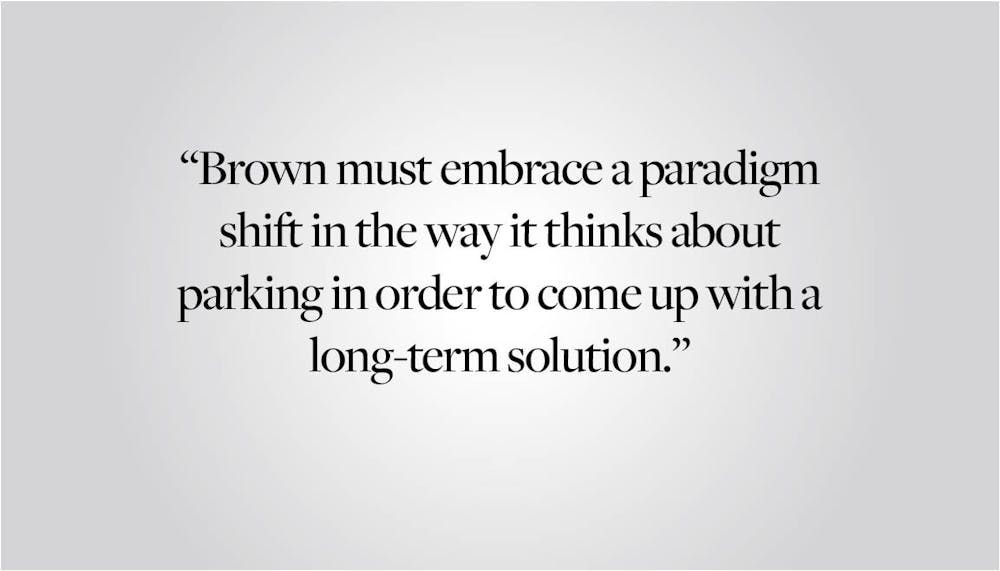For years, Brown has struggled to accommodate the parking needs of faculty and students. The available parking spots are currently allocated through a waitlist system and are ostensibly highly limited; in 2021, only around 50 juniors and seniors were granted parking spaces in this way. But closer inspection of Brown’s assets reveals that parking should not be the issue it has become for faculty, staff and students. The University has plenty of preexisting resources, including many underused lots, that could be reutilized to patch short-term holes in parking availability before Brown pivots to a new model.
The University’s current parking distribution system is complex and requires applying for a waitlist just to earn the privilege of paying hundreds of dollars for a parking pass. This flawed system has another significant impact on campus life and the surrounding community that goes beyond creating inconvenience and financial burdens for students. Parking regimes like the University’s can create traffic as vehicles circle blocks searching for spots and reduce the space available to neighborhood residents as visitors elect to park on city-owned streets.
If Brown is willing to critically evaluate its current system, it could provide significantly more parking with assets it already owns and pays for. One of the University’s most significant parking holdings is the Brown Stadium lot north of campus. This lot has at least 150 spots and is possibly the largest untapped parking resource the University owns — save for gamedays, it remains vacant almost every day of the year. While this lot is not within walking distance of the main campus, especially for daily commuters, Brown can employ another underutilized resource to help: the campus shuttle. By organizing consistent shuttle transportation between the lot and the main campus, a trip which normally takes about ten minutes, the University would be able to effectively circulate commuters between the lot and campus. Brown should have no logistical issue diverting shuttles to the lot every ten minutes throughout the day, as it already does so for game days without causing any significant disruption to service elsewhere around campus.
This plan would not be too cost-prohibitive as the University already has nearly everything it needs to implement it. Brown might have to pay a small price to construct a covered shelter for commuters or increase the amount they spend on the shuttle system to pay additional drivers, but these are hardly large outlays considering the continued demand for additional campus parking.
Brown should also consider finding ways to fill lots that are underutilized — walking by the Olney-Margolies Athletic Center or looking out the windows of the John D. Rockefeller Library, I’ve noticed consistently empty spaces in the adjacent lots. If those spaces do often sit empty, Brown must flexibly reallocate them.
These short-term solutions are particularly attractive since they can be implemented immediately, to great effect and at next to no capital cost. Commuters currently struggling with this issue should not need to wait years for a potential new parking facility to be built, and Brown could quickly ease any stress on surrounding streets caused by their current allocation of parking.
But Brown must also embrace a paradigm shift in the way it thinks about parking in order to come up with a long-term solution. Students at many schools, both urban and suburban, struggle with parking, but many schools are doing more to meet the demand of their commuters than Brown. Schools large and small have recognized the need for parking not immediately adjacent to their main campuses and have seen success with shuttle services or simply longer walks from parking to campus destinations. Schools like the University of Michigan have embraced this strategy and have made their larger parking facilities stops on their many campus shuttle routes. Likewise, smaller universities have relocated their many smaller lots to single large garages, like Wellesley College, which replaced its previous facilities with a 566-space ramp, allowing for the ecological restoration of many parts of campus.
Brown should not fall behind its peers in this regard. In the near term, the University should open any underused lots, but not disregard the importance of building a large multi-level facility to permanently end the parking issue. There are a number of places where this could be effectively implemented, such as large surface lots around the athletic facilities. Doing so would provide a large parking facility in an unobtrusive area for the neighborhood and allow for suitable parking within walking distance of campus.
The benefit of implementing both short-term and long-term campus parking solutions would be enormous. It would free up street space for pedestrians, bicyclists and other forms of transportation. Additionally, it would reduce traffic, as there would be fewer drivers hunting for on-street parking.
Furthermore, it would allow Brown to pursue its development goals more effectively. As the University continues to expand its built footprint, it often replaces on-campus parking with new facilities. One of the new dorms on Brook Street, for example, was built on a large University-owned lot. The same can be said for Sternlicht Commons — the dorm often referred to as Wellness. By providing adequate parking apart from the main campus, Brown can engage in infill development, filling space formerly occupied by surface lots made obsolete by new off-campus parking without displacing any existing structures in the community.
Brown should demonstrate its dedication to resolving its parking problems as soon as possible by taking the first step of providing easier access to their underused lots. Then, it can take long-term steps to rethink campus transportation by moving parking off campus and lifting the roadblocks hindering further development.
Gabe Sender ’25 can be reached at gabriel_sender@brown.edu. Please send responses to this opinion to letters@browndailyherald.com and other op-eds to opinions@browndailyherald.com.
Gabe Sender is a Staff Columnist at The Brown Daily Herald with a particular focus on campus issues and development challenges in Providence. He is currently pursuing an independent concentration in urban environmentality.





